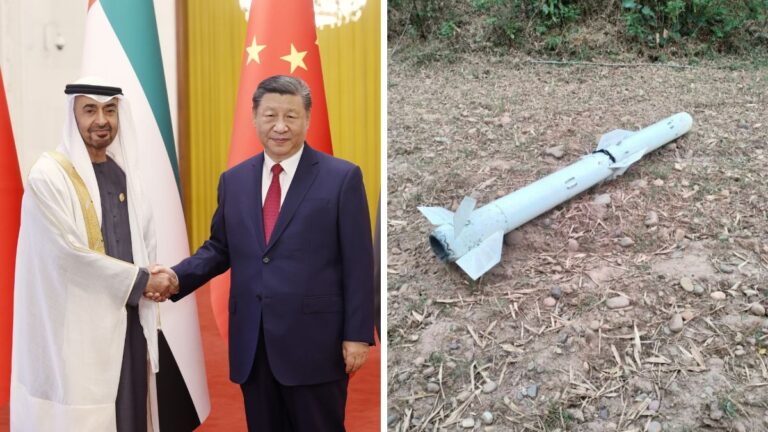US Intelligence Reports on Technology Transfer
Recent US intelligence disclosures indicate that critical technology used by China to enhance the capabilities of its air-to-air missiles, specifically the PL-15 and PL-17 models, was reportedly transferred by a United Arab Emirates-based company, G42, to Chinese telecommunications giant Huawei. This revelation emerged during the Biden administration in 2022 and raises significant geopolitical implications.
During Operation Sindoor in May, Pakistan claimed to have utilized the PL-15 missile to down an Indian warplane, marking a pivotal moment in the ongoing tensions between the two neighboring countries. The missile’s advanced design and capabilities have contributed to its growing significance in military engagements.
G42’s Role in Missile Technology Enhancement
G42, a prominent AI firm in the UAE, was responsible for facilitating the transfer of technology that upgraded long-range missile systems used by Chinese fighter jets. Reports suggest that this development has allowed Chinese aircraft to gain a distinct advantage over their American counterparts, particularly in terms of missile range and striking accuracy.
As an established buyer of the PL-15 missile system, Pakistan’s military has effectively integrated this technology in its operations against India. India has confronted this challenge head-on, notably recovering an intact PL-15E missile fired during the conflict, which is now under scrutiny by its Defense Research and Development Organization (DRDO). The DRDO aims to incorporate elements of the captured missile into its homegrown Astra missile program, bolstering India’s aerial capabilities.
Denials from G42 and Concerns from US Officials
In response to the allegations, G42 has publicly dismissed these claims as “false and defamatory allegations.” The firm maintains that the sources of the accusations are “questionable” in motive and intent. Meanwhile, US officials continue to deliberate on whether G42 was cognizant of the military ramifications of the technology transfer. The contention fuels speculation about the UAE’s strategic alignment with China amidst a backdrop of increasing cooperation between the two nations.
A former US official remarked that intelligence assessments have indicated that “G42 and the UAE were drifting into China’s orbit,” prompting heightened scrutiny from US intelligence agencies. The situation has galvanized discussions regarding the future of US-UAE relations, particularly in terms of defense and technology cooperation.
Geopolitical Implications of Technology Sharing
The technological exchange has sparked intense debate within the US government about whether to strengthen ties with the UAE, contingent upon its cessation of collaborations with China. Reports suggest that high-level US officials conveyed a stark message to the UAE’s national security adviser, emphasizing a crucial choice between alignment with the US or engagement with China within the burgeoning AI sector.
Concerns have been raised regarding the nature of the technology shared by G42 with China. The firm has been diversifying its endeavors into areas such as geospatial, aerospace, and satellite technologies. It is believed that the technology involved software improvements designed to enhance missile flight optimization.
Evolving Dynamics in Middle Eastern Alliances
As the Biden administration examines the shifting alliances within the Middle East, the implications for US foreign policy are profound. The transfer of operational capabilities to China through UAE networks could redefine the balance of power in the region, particularly in air combat capabilities. Observers note that China’s robust advancements in air-to-air missile technology throughout the 2010s have already placed it on a competitive footing against US military assets.
The potential for G42’s partnership with Huawei to transform Chinese military capabilities cannot be understated. By leveraging advanced technology in their defense industry, China seeks to narrow the gap in military sophistication compared to Western forces.
Countermeasures by the Biden Administration
The Biden administration has promptly addressed the concerns surrounding this technology transfer, with high-ranking officials dispatched to the UAE to discuss the implications of the collaboration with Chinese entities. They underscored the necessity for the UAE to evaluate its strategic priorities within the context of evolving US-China relations.
Moreover, the administration’s long-term strategy focuses on maintaining a stable partnership with the UAE, even as concerns about Chinese influence continue to mount. Response mechanisms are being developed to counter any potential adverse effects stemming from G42’s technological transfers.
Conclusion
The revelations surrounding the UAE’s technology transfer to China underscore the complexities and intricacies of modern geopolitical alliances. As tensions escalate in South Asia, and the impact of advanced air-to-air missile technology becomes evident, both the US and its allies must navigate this evolving landscape.
This article sheds light on the intricate dynamics of international relations and the technological arms race, particularly in the context of military advancements in air combat. It reflects a critical moment in the interplay between US interests and emerging alliances within the Middle East.
Published on 1761548147 • Category:
Images are for reference only.Images and contents gathered automatic from google or 3rd party sources.All rights on the images and contents are with their legal original owners.

